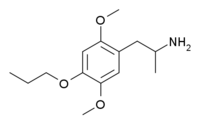MPM (psychedelic)
Topic: Chemistry
 From HandWiki - Reading time: 2 min
From HandWiki - Reading time: 2 min

| |
| Names | |
|---|---|
| Preferred IUPAC name
1-(2,5-Dimethoxy-4-propoxyphenyl)propan-2-amine | |
| Other names
2,5-Dimethoxy-4-propoxyamphetamine; 2,5-Dimethoxy-α-methyl-4-propoxybenzeneethanamine
| |
| Identifiers | |
3D model (JSmol)
|
|
| ChemSpider | |
PubChem CID
|
|
| UNII | |
| |
| |
| Properties | |
| C14H23NO3 | |
| Molar mass | 253.342 g·mol−1 |
Except where otherwise noted, data are given for materials in their standard state (at 25 °C [77 °F], 100 kPa). | |
| Infobox references | |
Tracking categories (test):
MPM (2,5-dimethoxy-4-propoxyamphetamine) is a lesser-known psychedelic drug and a substituted amphetamine.
MPM was first synthesized by Alexander Shulgin. In his book PiHKAL, dosage is given as "30 mg or more" and duration "probably short".[1] MPM is of low potency and produced only slight effects at the highest dose reported in PiHKAL of 30 mg, although its effects at higher doses than this have not been reported.
Very little data exists about the pharmacological properties, metabolism, and toxicity of MPM.
See also
- Phenethylamines
- Psychedelics, dissociatives and deliriants
References
 |
Licensed under CC BY-SA 3.0 | Source: https://handwiki.org/wiki/Chemistry:MPM_(psychedelic)19 views | Status: cached on July 22 2024 12:34:35↧ Download this article as ZWI file
 KSF
KSF